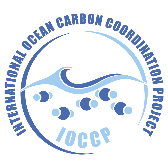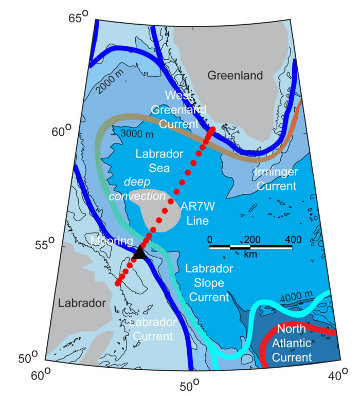Atlantic Zone Off-Shelf Monitoring Program (AZOMP)
The Labrador Sea Monitoring Program collects and analyzes physical, chemical and biological oceanographic observations along a 800 km line of stations across the Labrador Sea. The Atlantic Repeat Hydrography Line 7 West line (AR7W), take its origin from the 1990-2002 World Ocean Circulation Experiment WOCE, a global Hydrographic survey aiming to represent the physical and chemical "state of the oceans" and provide the oceanic data necessary to models the Global climate.
Since then, the line have been occupied annually, typically in May, with the addition of more in depth chemical and biological measurements. Oceanographic conditions and atmosphere-ocean interactions in the Labrador Sea are of particular importance because:
- Amongst few areas of the global ocean where intermediate-depth water masses are formed through the convective sinking of dense surface water.
- The atmosphere-ocean interactions allows for the “ventilation” of the deeper ocean by transporting atmospheric gasses and heat into the deeper layer of the Northwestern Atlantic Ocean, particularly Among carbon dioxide
- The intense Winter mixing, also allows nutrients rich water to reach the surface, playing an important role into the formation and intensity of the primary production within the region.
- It is a key region for the forcing and modification of the Labrador Current system which has a major influence on oceanographic conditions on the Atlantic Canadian shelf.
- It is a gateway for the freshwater originating from the Arctic Ocean and Greenlandic glacial melt flowing input in the Northwestern Atlantic
With a more than 30 years long timeseries the fundamental goal of the monitoring program remains the same, although now, in addition to interannual, interdecadal variability are now becoming in reach to enable longer term understanding of the oceanic systems and better document the changes we are witnessing.
With the addition of new technologies in the form of autonomous buoys like the ARGO or with Ocean color satellite imagery, monitoring seasonality changes and shorter timescale at a larger spatial scale becomes accessible. The at-sea program allows for maintenance and calibration of these remote sensed tools.
Measured Variables:
- CTD Sensors (T-S-O-Fluorescence-Transmittance)
- Salinity
- Transient tracer (CFC/ SF6)
- Carbonate Chemistry (DIC, pCO2, CH4, pH and TA)
- Dissolved Oxygen (Winkler), O18
- Pigments (HPLC and Turner method for Chl-a)
- Nutrients (Nitrite, Nitrate, Phosphate, Silicate and Ammonia) and POC
- Absorption and CDOM
- Flow cytometry
- Primary Production (P-I curve)
- Mesozooplankton abundance and biomass
- Secondary production (Egg production rates)
Research contributions
Products from the AZOMP is also a DFO contribution to international programs focused on observational of ocean condition variability, global climate change and carbon cycling such as the:

International Ocean Carbon Coordination Project

Global Ocean Observation System

Global Ocean Ship-based Hydrographic Investigations Program

Climate Variablility and Predictability
Research Document Data
Terms of use
The data provided under this program can be redistributed and/or modified under the terms of the Government of Canada Open Data License Agreement.
The data are licensed as is. Fisheries and Oceans Canada:
- makes no representation
- gives no warranty whatsoever with respect to the data
- expressly disclaims any implied warranty of merchantability or fitness for a particular purpose of the data
Fisheries and Oceans Canada assumes no obligation or liability whatsoever for the provision of updates to the data.
Environmental conditions in the Labrador Sea
Optical, Chemical, and Biological Oceanographic Conditions in the Labrador Sea between 2014 and 2018
Also Reporting to


Access to data
Most oceanographic data collected during the program missions at sea, whether they are originate from discrete bottle data, sensor data or other means of sampling are currently archived on the following different internationally recognized data repositories. For other inquiries please contact the DFO.AZOMP-PMZAO.MPO@dfo-mpo.gc.ca
Contact information
Send your questions about the program to the AZOMP mailbox.
- Date modified:




